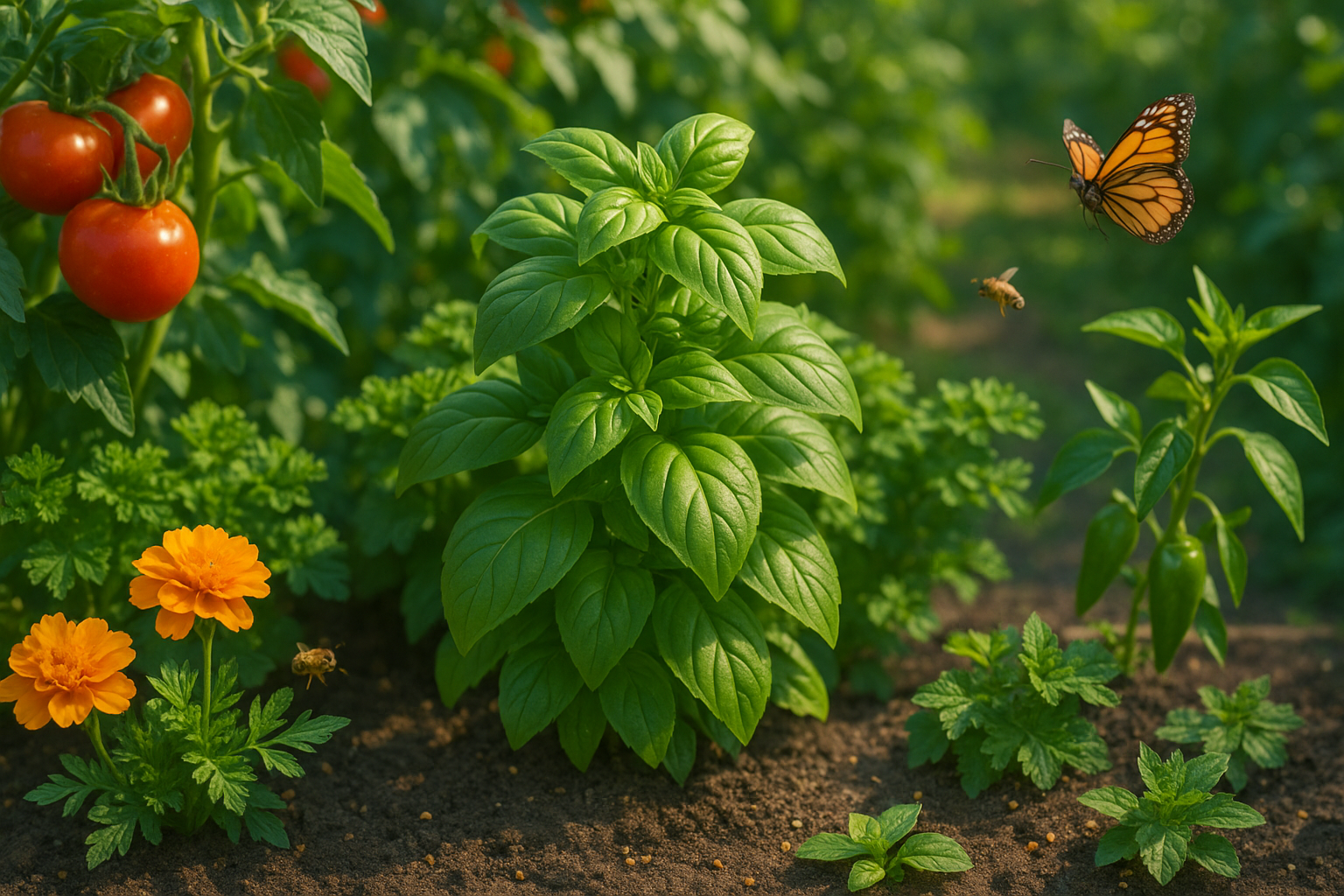Introduction
Basil companion plants can make all the difference between a thriving herb patch and a garden full of frustration. As one of the most popular—and versatile—herbs grown at home, basil adds a refreshing aroma and flavor to countless dishes. However, its success doesn’t just depend on sunlight and water. The plants you choose to grow alongside basil, known as companions, can have a remarkable impact on its health and productivity.
Companion planting is the practical art of pairing specific crops together to boost growth, deter pests, and enhance flavors naturally. For basil, choosing the right neighbors means not only bigger and tastier leaves but also a reduced need for pesticides and chemicals. For instance, pairing basil with tomatoes is a time-honored trick that benefits both plants through improved growth and pest resistance.
But not all plant pairings are helpful—some can stunt basil’s growth or even cause it to wilt. In this post, we’ll break down which basil companion plants are most beneficial, as well as which to avoid, giving you the upper hand whether you’re a seasoned gardener or just starting a culinary window box. Let’s explore what pairs beautifully with basil and what should be kept at a safe distance.
What Is Companion Planting?
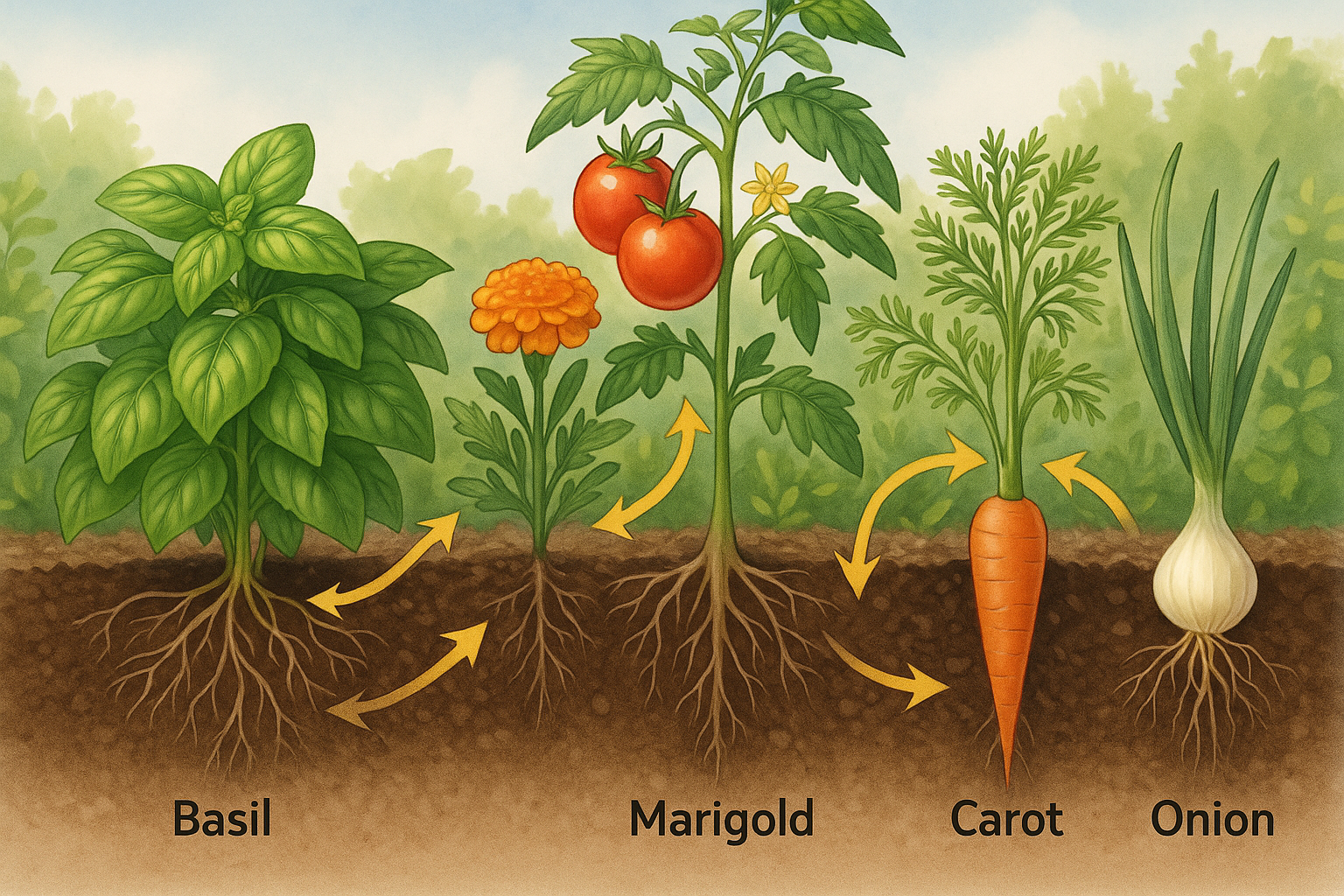
Companion planting is a gardening technique where different plant species are grown close together to benefit one or both of them. The idea dates back centuries and is rooted in both traditional wisdom and modern science.
At its core, companion planting works by leveraging the natural interactions between plants. Some plants, like basil, release chemicals that repel pests from neighbors such as tomatoes. Meanwhile, marigolds emit substances through their roots that deter nematodes and soil-borne insects—a phenomenon known as allelopathy.
Certain plant pairs also attract beneficial insects or pollinators. For example, nasturtiums lure aphids away from more vulnerable crops, and sunflowers draw bees to improve pollination. This approach not only helps reduce the need for chemical pesticides but also boosts crop yields and overall garden health.
In organic and small-space gardening, companion planting is especially valuable because it allows gardeners to maximize limited space while maintaining soil fertility and minimizing pest problems naturally. For example, planting carrots and onions side by side means the onion’s scent confuses carrot flies, while the carrots mask the onions from onion flies.
By understanding how plants interact above and below ground, gardeners can create more resilient, productive gardens with less effort and fewer inputs. Companion planting transforms your garden into a balanced ecosystem, making it a smart, sustainable strategy for gardeners of any level.
Why Companion Planting Matters for Basil
Basil thrives in warm weather with plenty of sunlight, ideally needing at least six hours of direct sun each day. It prefers moist, well-drained soil rich in organic matter, and consistent watering helps basil develop lush, aromatic leaves. But beyond tending to its basic needs, companion planting can truly elevate your basil’s health and productivity.
Pairing basil with the right neighbors can bolster its natural defenses, improve flavor, and even boost yields. For example, tomatoes are a classic companion for basil—gardeners have long noticed that planting these two close together results in sweeter, more flavorful tomatoes while keeping pests like thrips and aphids at bay.
The strong scent of basil helps mask the smell of tomatoes, confusing pests and reducing infestations. At the same time, basil benefits from the shared shade and microclimate that tomato plants provide, which helps retain soil moisture and reduces stress on hot days. Some even claim that basil’s aromatic oils make tomatoes taste better, creating a win-win for your summer harvest.
So, by aligning basil with friendly companion plants, you not only fulfill its individual needs but also create a healthier, more resilient, and productive garden ecosystem with less reliance on chemicals or pesticides.
Top Companion Plants to Grow With Basil
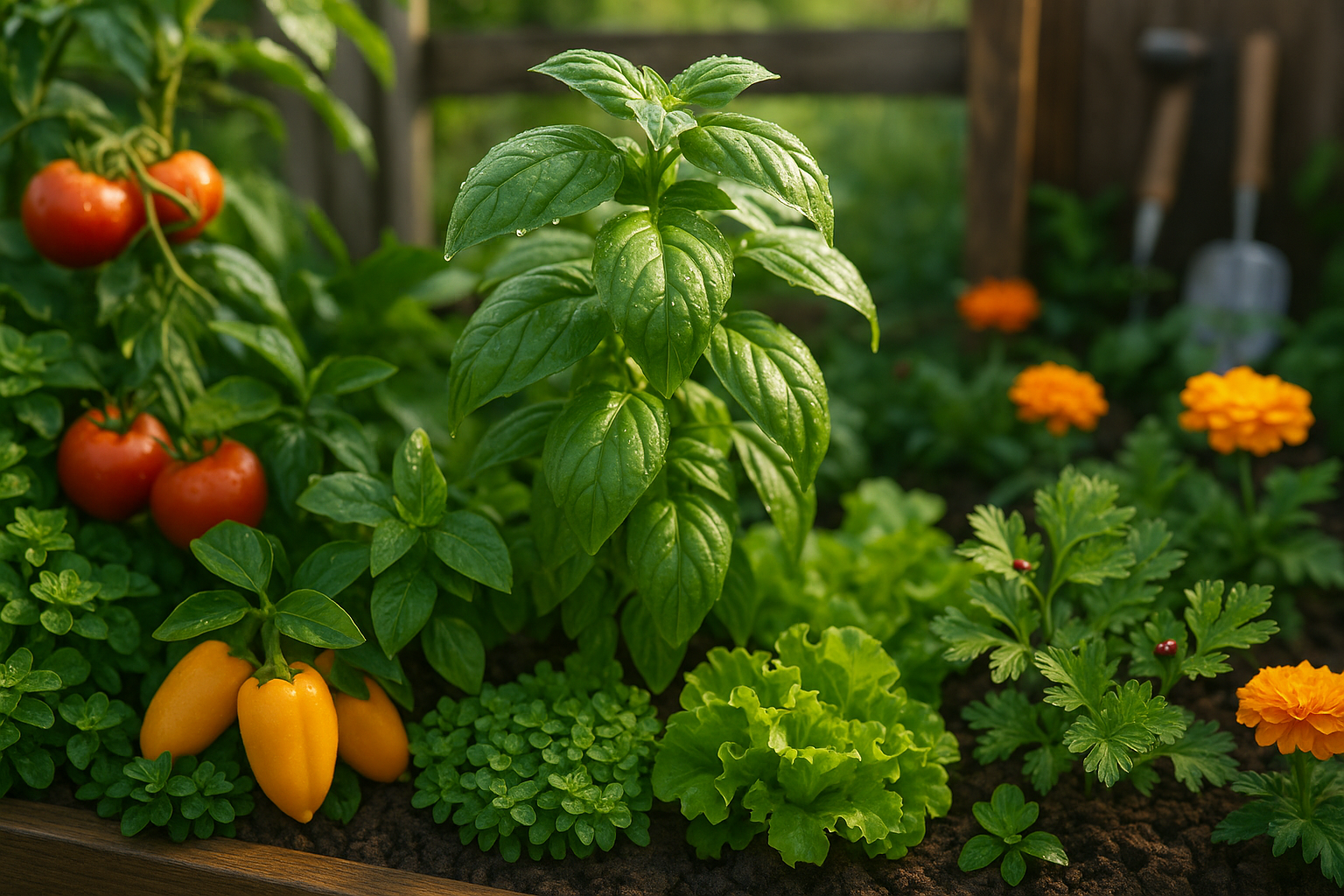
Basil thrives alongside a variety of garden friends, each offering unique benefits that boost its growth and flavor. Tomatoes are a classic partner, as their strong scent blends with basil’s aroma to deter pests like aphids and hornworms while also enhancing each other’s flavor—a win-win for salads and sauces.
Peppers prefer similar growing conditions (full sun and well-drained soil) and, when planted near basil, benefit from increased natural pest resistance thanks to basil’s aromatic oils. Nestle oregano and parsley nearby to bolster soil health; oregano spreads as a small ground cover that shades the soil and suppresses weeds, while parsley attracts beneficial insects that keep harmful bugs in check.
Lettuce is a perfect underplanting for basil’s taller stems, acting as living mulch that helps retain soil moisture and coolness, making it ideal for warmer climates or raised beds. Marigolds are natural pest repellents whose vibrant blooms attract pollinators and ward off nematodes and beetles, so consider bordering your basil bed with them.
For root crops like carrots, plant them beside basil to take advantage of different root zones—carrots grow deeper underground while basil’s roots stay shallow, minimizing competition. Zucchini can also be included on the edge of your basil patch, but give it ample space since its broad leaves spread out; basil will benefit from the shade, reducing heat stress in midsummer.
When laying out your garden, alternate rows or clusters of basil with these companions, ensuring taller plants like tomatoes and peppers don’t shade out your sun-loving basil. Use marigolds or lettuce at the borders to maximize pest protection and conserve soil moisture. This thoughtful combination results in a healthy, productive, and naturally resilient garden.
Benefits Beyond the Garden Bed
Companion planting offers gardeners a wealth of benefits that go far beyond just making the most of your garden bed. By thoughtfully pairing plants, you attract beneficial insects like bees and butterflies, boosting pollination and leading to better harvests.
Planting colorful flowers such as marigolds alongside your vegetables not only enhances your garden’s visual appeal but also naturally deters pests. For example, basil is known to help repel aphids and mosquitoes when grown near tomatoes, cutting down on the need for chemical pesticides.
Legumes like beans, when planted near leafy greens, naturally enrich the soil with nitrogen, reducing the need for synthetic fertilizers.
However, to make the most of mixed plantings, it’s essential to avoid some common mistakes:
- Don’t overcrowd your beds—plants need space for roots and air circulation to stay healthy.
- Avoid pairing incompatible plants, such as those that compete for the same nutrients or attract the same pests. For instance, keep onions away from beans, as they can inhibit each other’s growth.
Taking time to plan your garden layout and do a bit of research on plant compatibility will lead to a thriving, low-maintenance, and eco-friendly garden.
What NOT to Grow With Basil
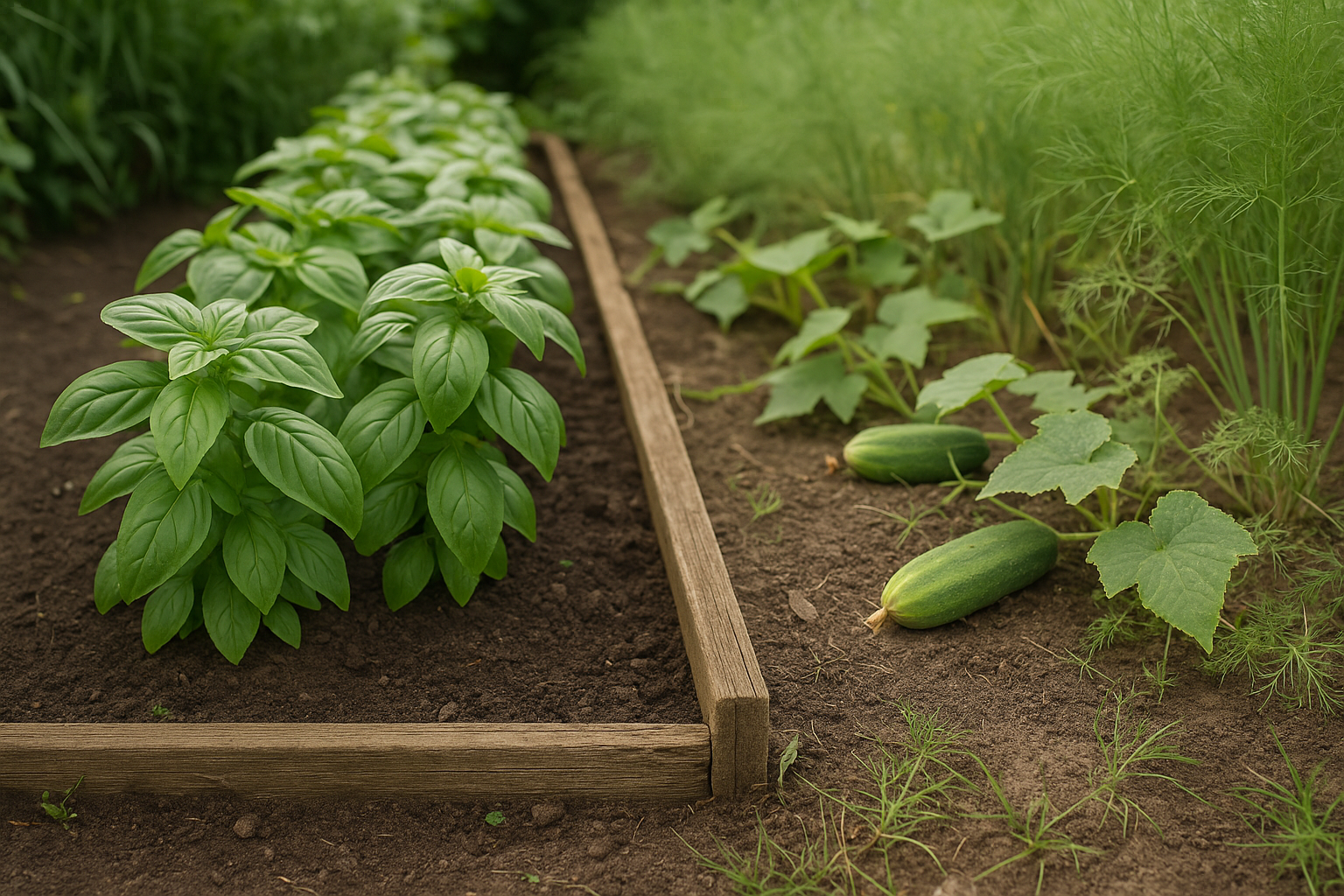
While basil is famously friendly in the garden, there are some plants you should keep at a distance to ensure it thrives. Cucumbers, for example, compete with basil for water and nutrients, often leading to stunted growth in both crops. Fennel is another no-go—it releases allelopathic chemicals into the soil that can hinder basil’s development and even suppress nearby herbs and vegetables.
Sage and rue don’t get along well with basil either; both release substances or create conditions in the soil that can disrupt basil’s growth and essential oil production. If you want to cultivate these plants, it’s best to allocate different zones within your garden.
Try growing basil in containers or raised beds, which allows you to move it around and keep it separated from unfriendly neighbors like fennel, sage, and rue. For cucumbers, consider placing them on the opposite side of your garden with plenty of space, or build a simple border to prevent roots from mingling.
This separation helps every plant get the conditions it needs without negative interference, ensuring a healthy, productive garden for all.
Simple Steps for Successful Companion Planting
Companion planting with basil is an easy and rewarding way to boost your garden’s health and yield. Start by spacing each basil plant about 12–18 inches apart to promote air circulation and prevent overcrowding, which helps reduce disease.
Basil thrives alongside tomatoes, peppers, or lettuce—plants that also prefer consistent moisture. Be sure to water at the base of your plants early in the day to lower the risk of fungal issues and encourage strong root growth.
For the best results, rotate your crops each season. Avoid planting basil in the same spot year after year to minimize pest and disease buildup in the soil.
As your basil and its companion plants grow, watch for signs of yellowing leaves, stunted growth, or pest damage, and address any problems promptly before they spread.
Don’t hesitate to experiment with small groupings—like a pot with basil, chives, and marigolds—so you can discover what works best in your unique environment. By observing and adjusting your combinations, you’ll find the most harmonious companion pairs for your space, leading to healthier plants and a more productive garden.
Conclusion & Quick Reference Table
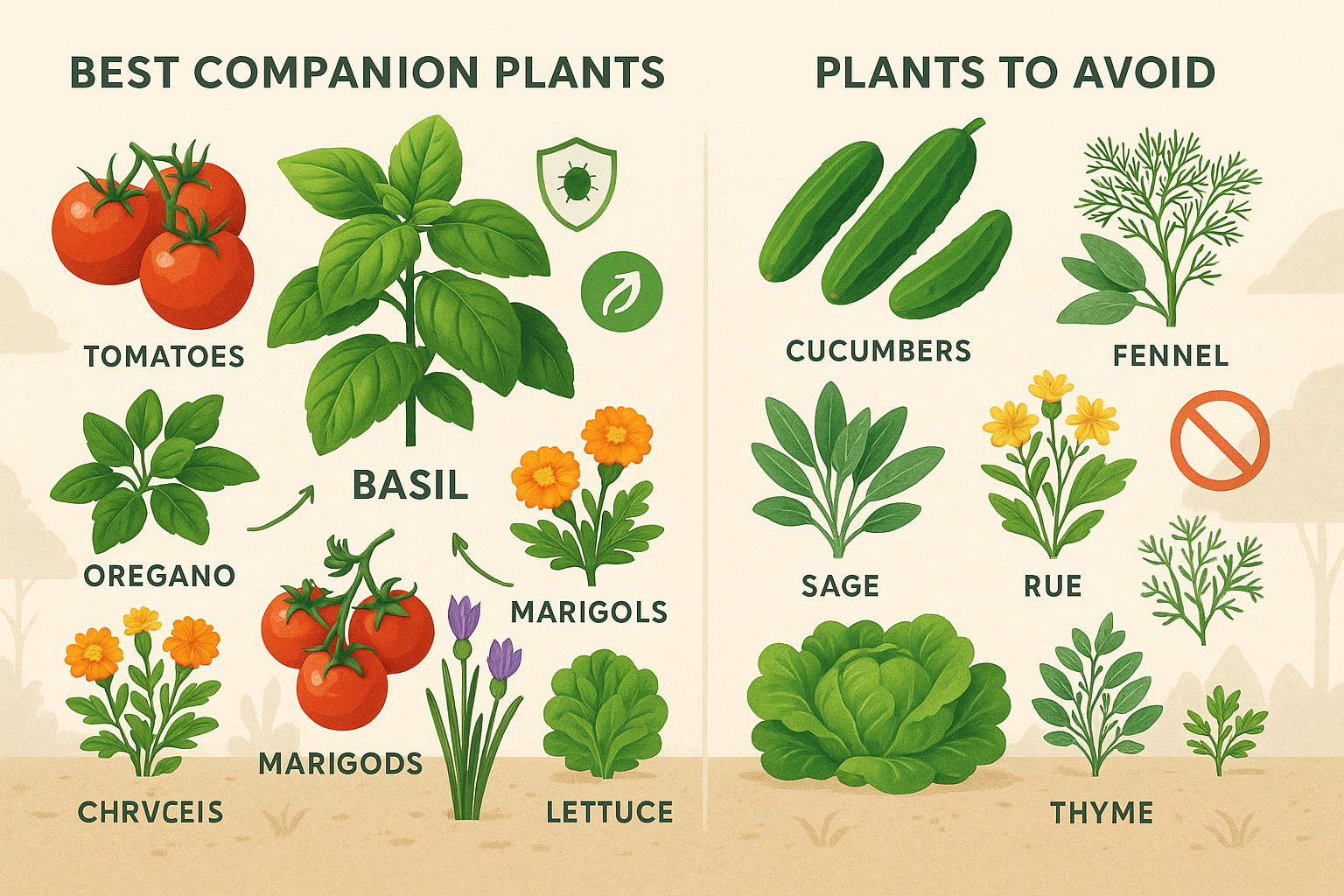
Thoughtful companion planting can make a big difference in how well your basil grows, boosting its flavor, deterring pests, and even improving yields. By choosing the right companions, you create a balanced mini-ecosystem where plants naturally support each other. Remember, every garden is unique—sunlight, soil, and climate all play a role—so take time to observe what works best in your space. Experiment with a few combinations to see which ones thrive, and don’t be afraid to adjust over time.
Below is a quick guide to help you make smart choices for your basil companion planting:
| Best Companions | Worst Companions |
|---|---|
| Tomatoes | Cucumbers |
| Peppers | Fennel |
| Oregano | Sage |
| Marigolds | Rue |
| Chives | Common Rue |
| Lettuce | Thyme |
Use this table as a starting point and enjoy a healthier, more vibrant basil harvest!
